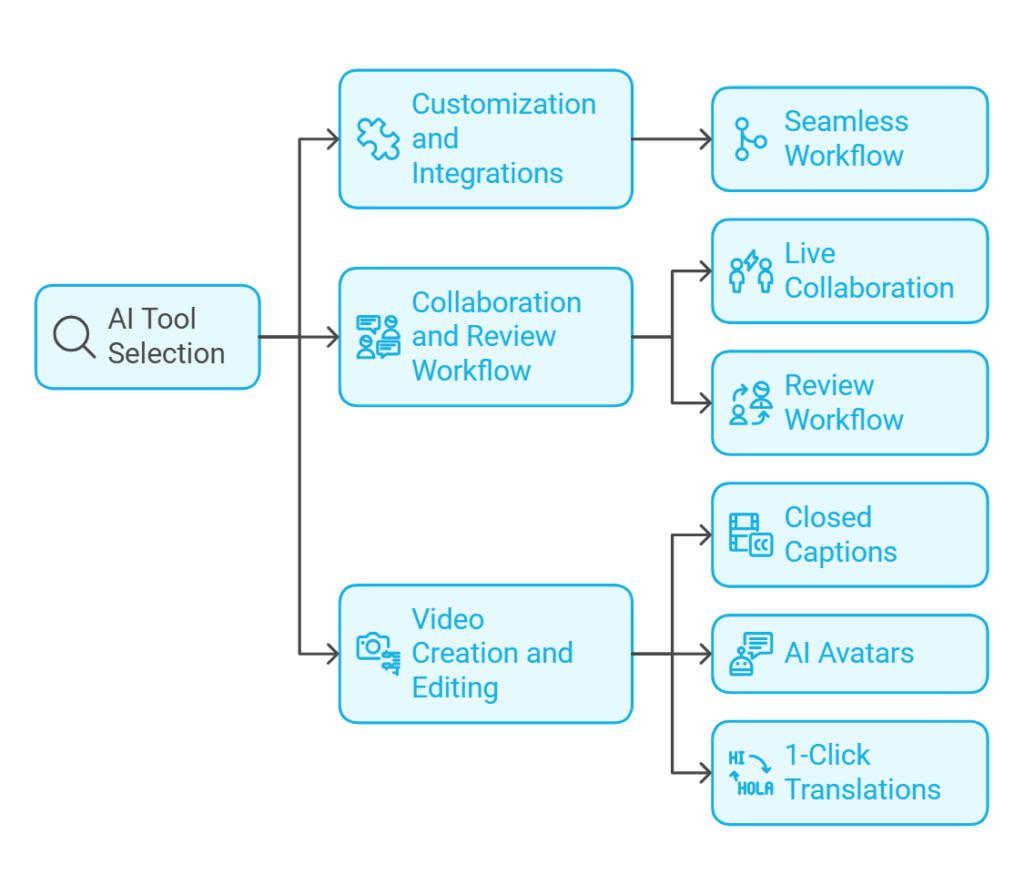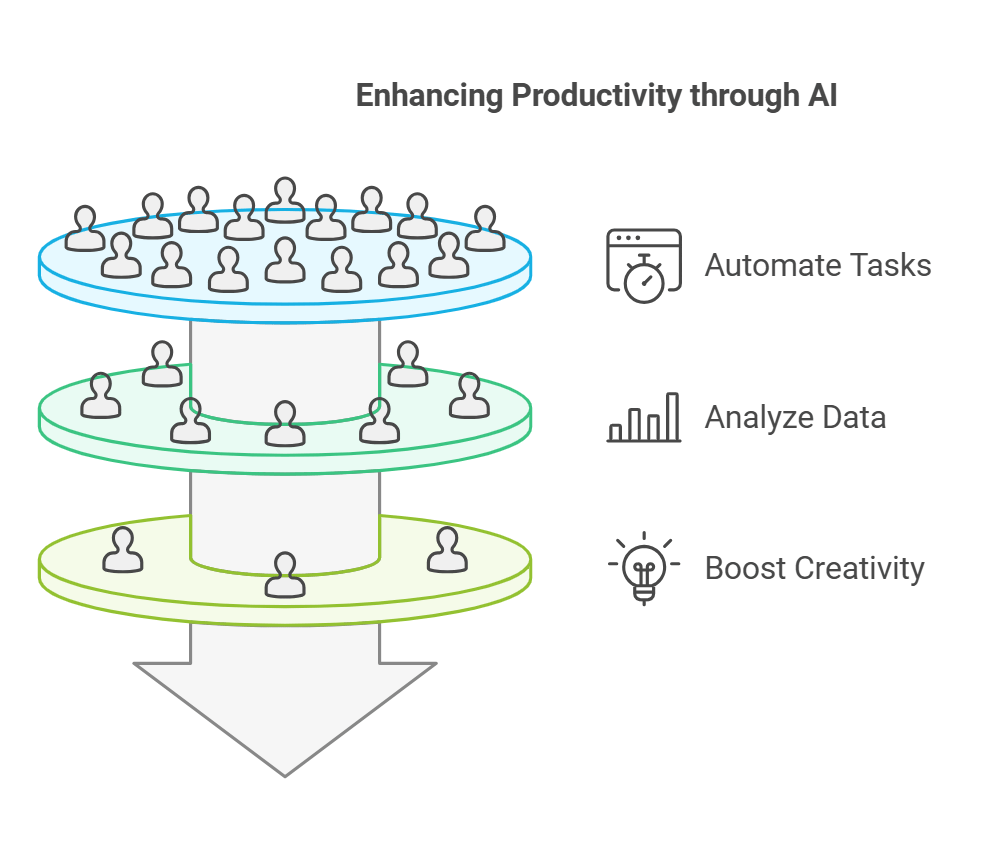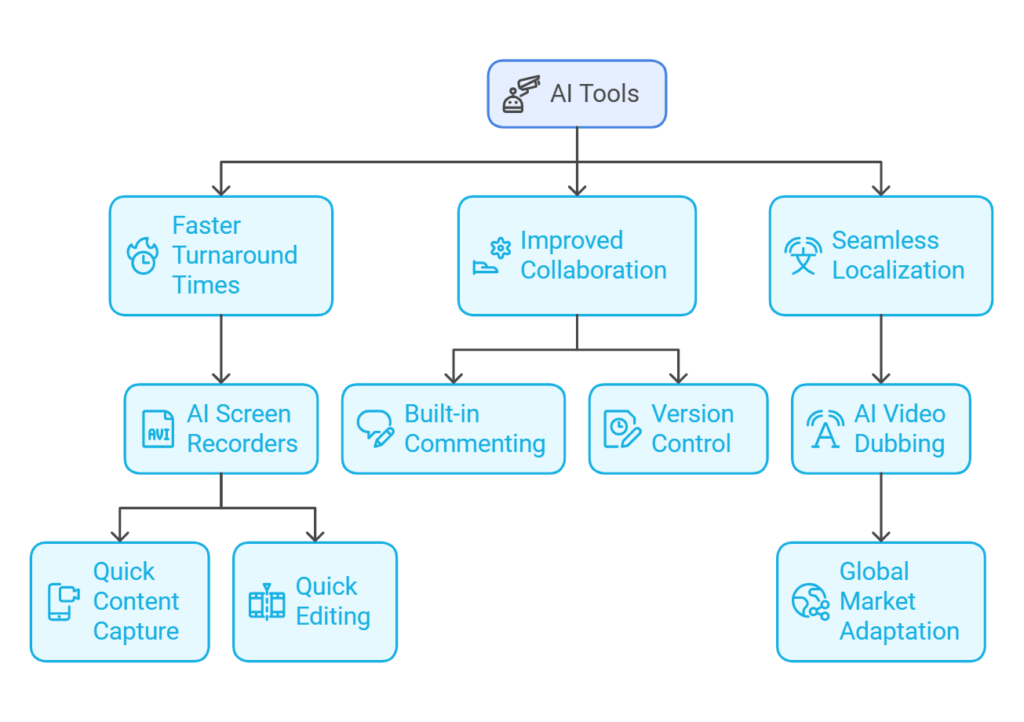As we move further into 2025, AI tools are rapidly transforming the way we work, create, and interact. From video editing to customer service, the rise of AI is shaping the future across industries—and businesses are taking notice. But with so many AI platforms and features now available, how do you decide which ones will truly elevate your business? What tools will streamline your processes, enhance productivity, and give you the edge you need to stay ahead of the competition?

Whether you’re looking to create engaging video content, automate workflows, or improve collaboration within your team, AI tools are more accessible and powerful than ever. In this blog, we’ll explore the top AI tools in 2025, diving into their unique features, integrations, and capabilities. With everything from AI video dubbing and localization to collaboration features and app automation, you’ll discover how these tools can revolutionize your workflow.
Ready to dive into the world of AI and unlock the potential for your business? Let’s explore the AI-powered platforms that will change how you work—one tool at a time.
Understanding the Power of AI Tools in 2025
As the digital landscape evolves, businesses are faced with a fundamental question: How do we stay ahead in a world that’s constantly changing? The answer, for many, lies in the power of Artificial Intelligence. In 2025, AI tools are not just a luxury—they are a necessity for businesses looking to stay competitive, increase productivity, and enhance their customer experience.
So, what makes AI tools so valuable today?
AI-powered platforms offer an impressive array of features, from video creation to automated workflows, each designed to help businesses streamline their operations and unlock new levels of efficiency. But with so many options on the market, how can you make sense of it all? Let’s break it down.
Key Features to Look for in AI Tools

When choosing an AI tool for your business, it’s important to prioritize features that align with your specific needs. Here are a few key aspects to consider:
- Customization and Integrations: Does the tool offer flexible integrations with your existing software, like CRM or project management platforms? This allows for a seamless workflow and ensures you can get the most out of both your AI tool and your current systems.
- Collaboration and Review Workflow: Many AI platforms now include live collaboration features that enable your team to work together in real time, no matter where they are. This is perfect for businesses that rely on teamwork and need a review workflow that keeps everyone on the same page.
- Video Creation and Editing: AI tools designed for video creation and AI video editing are increasingly popular, especially for businesses looking to create compelling content quickly. Whether it’s adding closed captions, using AI avatars for dynamic presentations, or leveraging 1-click translations to localize content for international audiences, these tools make it easier than ever to produce professional-grade videos.

How AI Enhances Productivity
AI tools aren’t just about doing tasks faster—they also improve the quality of the work being done. Here’s how:
- Automation: With AI, you can automate repetitive tasks that take up valuable time. This includes everything from scheduling social media posts to managing your media library. Automation not only saves time but also reduces human error.
- Advanced Analytics: AI platforms can quickly analyze large volumes of data, providing insights that would take humans hours, if not days, to uncover. These insights can be used to refine marketing strategies, optimize customer service, and drive smarter business decisions.
- Increased Creativity: AI tools like AI avatars & voices enable you to explore new creative possibilities. Whether it’s enhancing a video project with realistic avatars or generating fresh ideas with AI-based content suggestions, these platforms push the boundaries of what’s possible.

Why AI is a Game-Changer for Businesses

By embracing AI tools, businesses gain access to the cutting-edge technology that drives business growth in 2025. These platforms offer more than just convenience—they empower businesses to operate at their full potential, providing:
- Faster turnaround times with tools like AI screen recorders that allow for quick content capture and editing.
- Improved collaboration with built-in commenting and version control features that ensure teams are always aligned.
- Seamless localization and AI video dubbing, allowing companies to easily adapt their content for global markets without missing a beat.
In essence, AI tools enable businesses to work smarter, not harder—empowering teams to focus on high-value tasks and giving organizations the flexibility they need to scale quickly and efficiently.
Ready to explore the next step in AI? Stay tuned as we dive deeper into the best AI tools to incorporate into your strategy this year.

Conclusion: The Future of AI Tools in 2025 and Beyond
As we’ve explored throughout this blog, AI tools are not just reshaping the way businesses operate in 2025—they’re revolutionizing the very essence of how we work, collaborate, and create. From video creation to automated workflows, the possibilities seem endless. So, the question remains: Are you ready to harness the power of AI for your business?
These tools offer far more than just efficiency—they bring innovation, creativity, and scalability to the forefront. With features like AI video dubbing for global reach, real-time collaboration to keep your team aligned, and automation with Zapier to streamline tasks, AI is transforming how businesses engage with their customers and optimize their internal processes. The future of business is digital, and AI is leading the way.
But it’s not just about choosing the right tool—it’s about finding the one that works for you. Does your business need better content creation tools? Or perhaps you’re looking for smarter ways to automate customer support with chatbots and AI avatars? Whatever your needs, AI tools in 2025 offer endless opportunities to enhance your workflow, improve collaboration, and drive growth.
Now, imagine what your business could achieve with the right AI platform. From increased productivity to stronger brand presence, AI has the potential to elevate your operations in ways you never thought possible.
So, as you consider the next step for your business, remember this: The future is AI, and it’s already here. Will you embrace it? The tools are waiting—ready to help you take your business to new heights.
Here are 10 AI tools that are extremely productive in every working domain-from writing and communications to project management and automation:
1. Notion AI
Category: Knowledge Management, Note-taking
What it is: In a nutshell, Notion AI organizes notes, creates summaries, generates ideas, and drafts documents in an instant. It is capable of lending a hand in brainstorming, writing, and managing your to-do list.
Why it is useful: Because it combines everything from notes, databases, and tasks into one nifty package with AI-enabled content creation and summarization.
2. Grammarly
Category: Writing, Communication
What it does: This AI tool helps to improve one’s grammar, style, tone, and by its ability to check for plagiarism. It supports casual and professional writing.
Why it is beneficial: It helps ensure that the quality of the communication becomes high as it tends to enhance the clarity, correctness, and overall flow of the written content.
3. Trello + Butler AI
Category: Project Management, Automation
What it does: Trello is completely a visual collaboration tool used in managing tasks and projects, whereas Butler is basically an automation that helps to automate actions, tasks, workflows, and anything repetitive in Trello.
Why it is useful: Benefit for groups that will keep everything organized for the work of the entire organization, saving time by automating repetitive project management tasks.
4. Zapier
Category: Workflow Automation
What it does: Zapier connects more than 5,000 apps to automate the possible workflows between them. For example, you can do things like send emails automatically, save email attachments in cloud storage or even create tasks using these project management tools.
Why it’s useful: Different applications automate repetitive tasks that increase productivity through his use rather than manual labor.
5. Otter.ai.
Category: Transcription, communication.
What it does: Otter.ai transcribes live meetings, lectures, and conversations and produces a searchable transcript that is accurate to the spoken word.
Why it’s useful: It saves the time from manual note-taking and greater accessibility by creating in-depth transcripts for future reviews.
6. AI-Powered Scheduling Assistants, such as Clara, x.ai.
Category: Scheduling, communication.
What it does: Such tools automate the scheduling process, taking into account the participants’ availability, and often integrate with both calendars and email systems.
Why it’s useful: No more back-and-forths while scheduling, letting us invest well in other priorities.
7. Click Up.
Category: Task management, collaboration.
What it does: ClickUp uses an AI project management tool to prioritize tasks, set reminders, and automate workflows while integrating with various third-party tools, including Slack or Google Calendar.
Why it’s useful: It is a real packed suite filled with productivity features-from task-tracking through timing to collaborating-all in one place, with several key processes being automated.
8. Jasper.
Category: Content Creation, Writing.
What it does:Jasper is an AI writing tool, which assists in drafting content for blog posts, social media, emails, advertisements, and a whole lot more. Jasper does produce high-quality copy from your directions.
Why it’s useful: Saves time during the drafting and brainstorming phases but with quality maintained for content creators.
9. Rescue Time
A tool focused on Time Management and Productivity Tracking, monitors the time allocated to different applications and websites. It offers valuable insights into productivity trends and areas where time optimization is possible. Its utility lies in aiding users to enhance focus, identify distractions, and receive suggestions for enhancing time management effectiveness.
10. AI Chatbots
Such as ChatGPT and Google Bard fall under the categories of Communication, Research, and Problem-Solving. These AI-driven chatbots are capable of answering queries, conducting research, facilitating idea generation, and producing written content. They prove beneficial for various productivity-related tasks including summarizing documents, composing emails, and resolving intricate questions promptly. The primary advantage rests in providing immediate access to information and simplifying a wide array of tasks, thereby expediting task completion.
